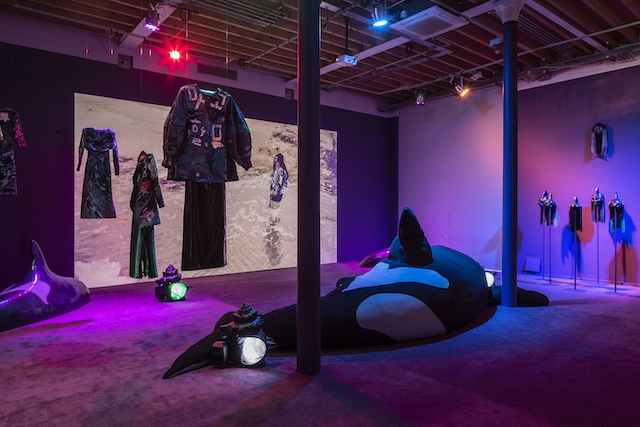“All creation legends are true”, claim the narrators of Zadie Xa’s film Child of Magohalmi and the Echoes of Creation (2019), part of her multimedia installation at Tramway. This rejection of singular narratives is reflected in the exhibition’s multiplicity and excess, encompassing film, sound, painting, sculpture, costume and performance. Through the combination of these elements, Xa reanimates the myth of Mago(halmi), a giant goddess who, in Korean folklore, is said to have created the world. In Xa’s hands the marginalised story of Mago is both a recuperative and speculative gesture, clamant with ecological portent.
Plunging the smaller of the gallery’s two spaces into darkness punctuated by colourful spotlights, Xa has carpeted the room and filled it with pseudo-aquatic sculptures: oversize resin conch shells and orcas, including an enormous denim orca, ‘Granny’, which demarcates the space. The effect is subaquatic but kitschily so, more Seapunk than a po-faced statement on ecology. According to the handout, ‘Granny’ is named after a real-life orca matriarch whose pod is under threat, but also serves as seating from which to comfortably watch the film that dominates the space.
Child of Magohalmi… is a mesmeric, narratively disjointed and at times slow-moving film, best absorbed in intermittent doses. Combining choreographed scenes and animation, its imagery ranges from a masked figure on a beach (Mago) as she creates the world from sand, water and her own bodily excretions, to pastel-hued kelp overlaid on waves. The film is at its most compelling when these sequences coincide with other elements of the installation, such as animated orcas leaping through a night sky, or the narrator’s mention of amethyst quartz, as the resin conch shells emit an eerie violet light.
Unlike Korean folklore concerning male deities, Mago’s story was never written down but transmitted orally through generations of women. The film’s self-interrupting narrative and onomatopoeic repetitions of “echo”, “gurgle” and “splash” vocalise Mago’s suppressed matrilineal narrative. Through the figure of this abject, terraforming goddess, Xa connects the excretions of the body and the accretion of land in a mutually fertilising cycle. It is Xa’s painting of Mago, however, that effects the presence of the goddess most strongly – only on a close look do you notice, nestled between the folds on Mago’s forehead, a half-closed but piercing third eye. This painting and the more handmade aspects of the installation – including denim orca-embellished costumes worn by performers dancing to Janggu drum rhythms on the opening night – bring a lightness and humour that balances out the comparatively self-serious film and its ambient soundtrack.
The array of references Xa draws on are at once conceptually alluring and politically salient. Allying a neglected matrilineal mythology with current ecological precarity, Child of Magohalmi… is a celebratory and ritualistic retort to patriarchal, monotheistic and Western-centric creation narratives and their progeny, found in present-day attitudes towards environmental extraction and destruction. While the exhibition may lack convincing aesthetic cogency, the powerful and provocative figure of Mago(halmi) – and her various incarnations by Xa and her collaborators – is defiantly unforgettable.
Zadie Xa, Child of Magohalmi and the Echoes of Creation, Tramway, Glasgow, 26 October through 15 December
From the January & February 2020 issue of ArtReview
